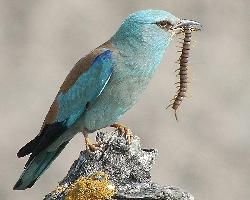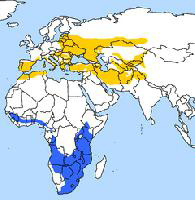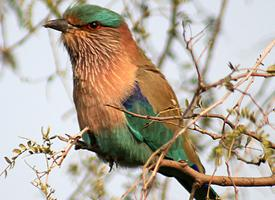
Váhy a míry
| Délka | od 29 do 32 cm |
|---|---|
| Hmotnost | 180 g |
| Délka rozpětí křídel | od 52 do 58 cm |
Stav ohrožení
| Ohrožen |
Popis zvířete
The European Roller (Coracias garrulus) is a fascinating and colorful bird that belongs to the roller family of birds, Coraciidae. It is known for its stunning plumage and acrobatic flight, which includes a series of rapid twists and turns, hence the name "roller". This medium-sized bird is approximately 29-32 cm in length, with a wingspan of 52-58 cm, and weighs between 110 and 160 grams. Its appearance is quite striking, with a combination of blue, brown, black, and green colors that make it one of the most beautiful birds in its range.The European Roller has a robust body, a strong, slightly hooked beak, and a short tail. The upper parts of the bird are mostly a warm brown, while the head, neck, and underparts exhibit various shades of light to dark blue. Its back is a stunning azure blue, and the wings display a beautiful range of blues when in flight. The tail is also blue with a darker terminal band. The eyes are dark, surrounded by a noticeable bare skin patch, which can be either pale or bright blue, contributing to its striking appearance.
This bird is a migratory species, spending the breeding season, which spans from late April to July, across a wide range stretching from Southern Europe to Western Asia and Northern Africa. It prefers open countryside with scattered trees and bushes, which are essential for nesting and perching. Traditional agricultural landscapes with low-intensity farming are particularly favored habitats. The European Roller nests in tree holes, old woodpecker cavities, or even in cliffs and buildings, where it lays 3-5 eggs that are incubated by both parents.
The diet of the European Roller primarily consists of insects, especially beetles, crickets, locusts, and caterpillars, which it often catches in flight with its agile aerial maneuvers. It is also known to consume small vertebrates, including frogs and lizards, making it an opportunistic feeder.
The European Roller is not only admired for its beauty but also plays a significant role in folklore and culture in its breeding areas. However, it faces threats from habitat loss due to agricultural intensification and pesticide use, which reduce its prey abundance. Additionally, the loss of suitable nesting sites due to the removal of old trees and traditional buildings poses a challenge to its population. Despite these threats, conservation efforts, including habitat management and the provision of artificial nesting sites, are being implemented in various parts of its range to help stabilize and increase its population.
The bird's flight is characterized by a combination of flapping and gliding, with the occasional dramatic display of rolling or fast, side-to-side twists. These aerobatic displays are particularly prominent during the breeding season, serving as a way to attract mates and deter rivals.
In summary, the European Roller is a captivating bird species, renowned for its vibrant colors and dynamic flight. As a symbol of unspoiled rural landscapes, it highlights the importance of biodiversity conservation and the need for sustainable agricultural practices to ensure the survival of this and many other species.
Mapa výskytu

Podobná zvířata
Nové fotografie zvířat
Top 10 zvířat
- Common cockchafer (Melolontha melolontha)
- Common house mosquito (Culex pipiens)
- Colossal squid (Mesonychoteuthis hamiltoni)
- Giant house spider (Eratigena atrica)
- Harpy eagle (Harpia harpyja)
- Fruit fly (Drosophila melanogaster)
- Common reed warbler (Acrocephalus scirpaceus)
- Australian box jelly (Chironex fleckeri)
- Proboscis monkey (Nasalis larvatus)
- Moustached guenon (Cercopithecus cephus)
